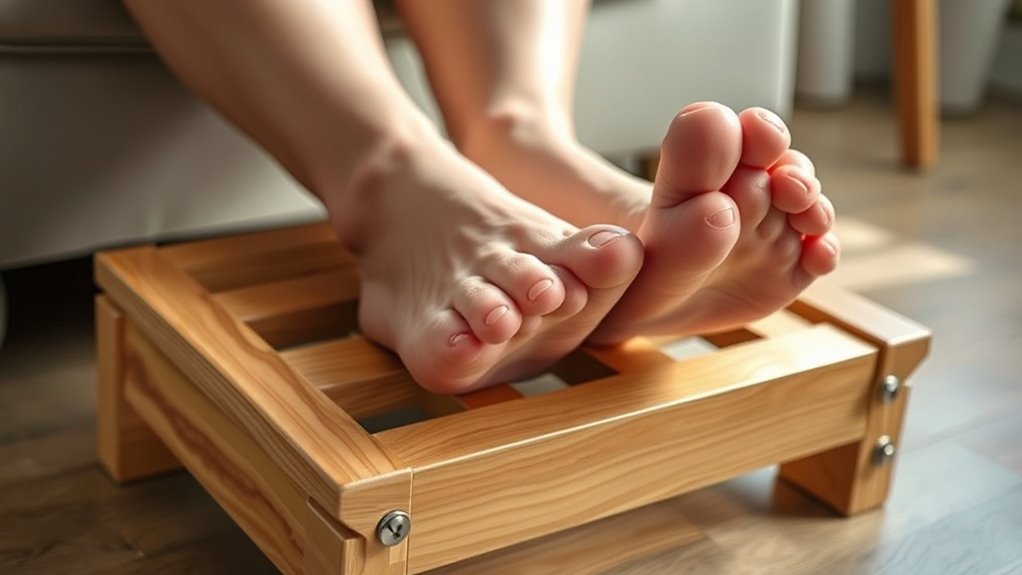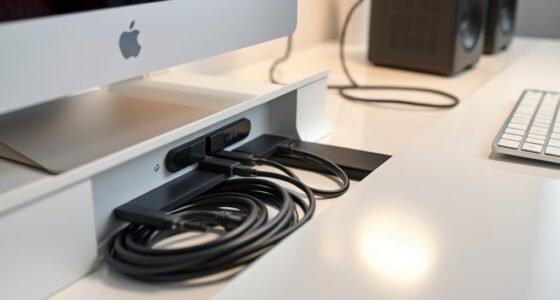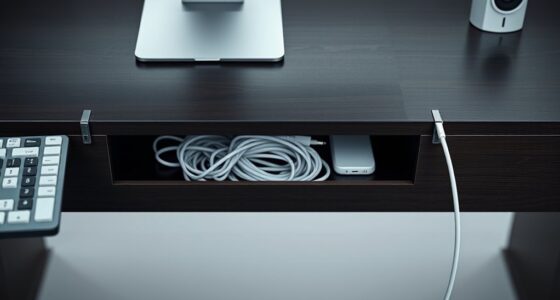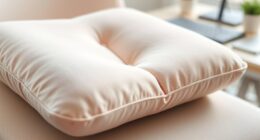To improve circulation while seated, you can easily create a DIY footrest using household items. Stack books or magazines for an instant elevate, or craft a cushioned stool with foam or pillows for added comfort. Repurpose old crates or boxes to assemble a sturdy, stylish footrest, or build an adjustable platform with recycled materials for customizable support. For ultimate convenience, opt for a foldable, portable design. Keep exploring for more creative solutions that suit your needs.
Key Takeaways
- Use stacked books or magazines to create an adjustable, quick-footrest that promotes better circulation and posture.
- Craft cushioned footstools with foam or pillows for customized support and improved blood flow.
- Repurpose old crates or wooden boxes as stable, eco-friendly footrests to enhance comfort and circulation.
- Assemble an adjustable, ergonomic footrest with recycled materials for personalized height and angle.
- Design a portable, foldable footrest for easy transportation and continuous circulation support while seated on the go.
Using Stacked Books or Magazines for Instant Elevation

If you need a quick and easy footrest, stacking books or magazines provides an instant solution. This simple method can offer ergonomic benefits by elevating your feet, reducing pressure on your lower back and legs. Proper foot elevation encourages better posture improvement, helping you sit more comfortably for longer periods. When you stack sturdy books or magazines to your preferred height, you create a supportive platform that promotes healthy alignment. Confirm the stack is stable to prevent slipping or toppling. This DIY approach is cost-effective, easily adjustable, and accessible, making it ideal for temporary or immediate use. Additionally, understanding the importance of contrast ratio in projectors can help you choose the right visual setup for your space. Keep in mind, while it’s a quick fix, it’s always best to switch to more supportive solutions for sustained comfort.
Crafting a Cushioned Footstool With Foam or Pillows
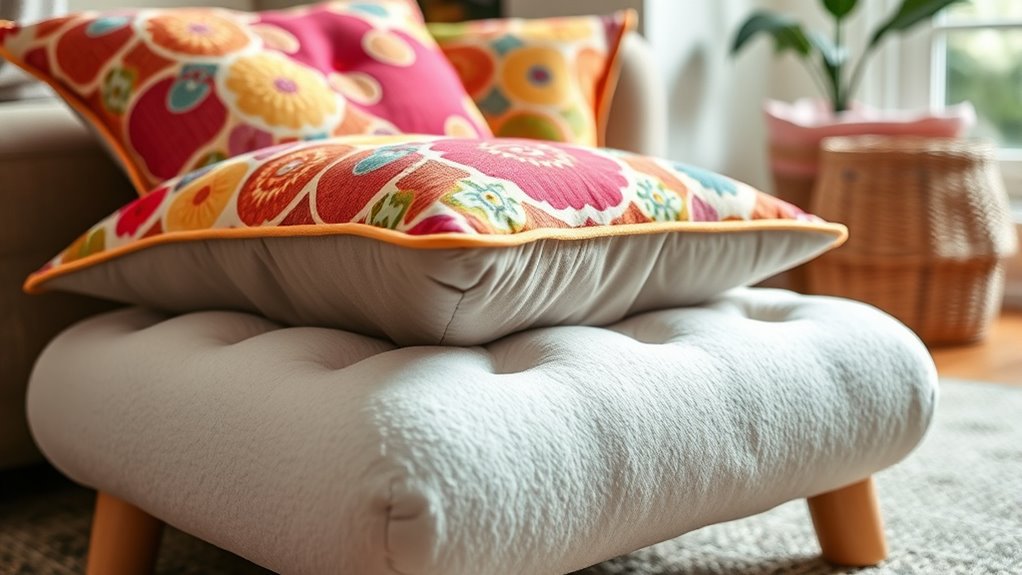
Creating a cushioned footstool with foam or pillows is a simple way to enhance comfort and support while sitting. Start by choosing a sturdy base, like a small wooden crate or box. For padding, layer foam padding or fill a pillow with soft pillow filling to suit your preferred firmness. Wrap the foam or pillow in fabric, ensuring it’s snug and secure. Attach the cushion to your base with adhesive or fabric ties. The foam padding provides firm support, while pillow filling offers plush comfort. Adjust the filling to your liking for ideal support. This DIY project is quick, affordable, and customizable, giving you a comfortable footrest that helps improve circulation and relieves pressure during long periods of sitting. Incorporating portable cushioning options can further enhance comfort and adaptability.
Repurposing Old Crates or Wooden Boxes as Footrests
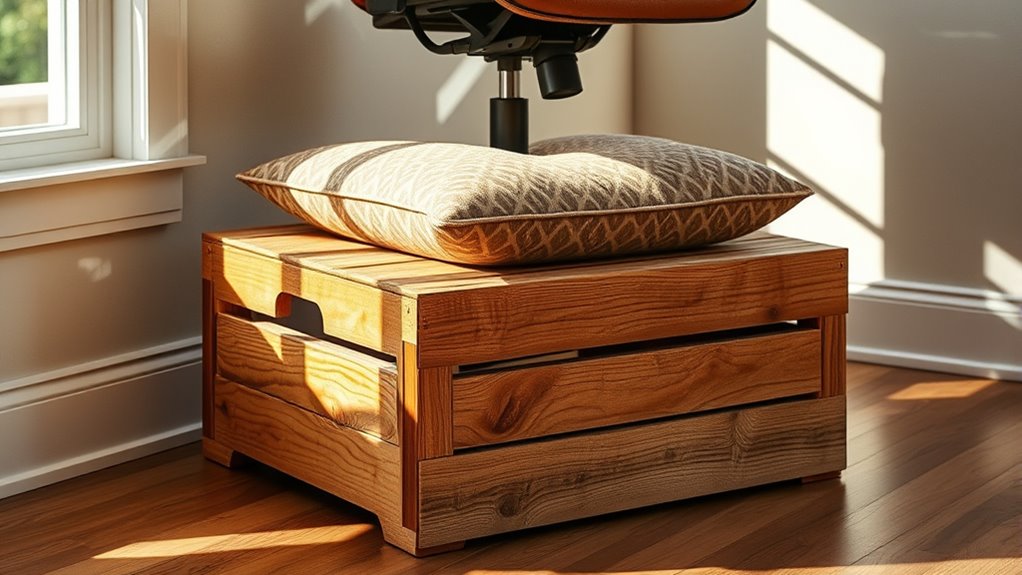
Repurposing old crates or wooden boxes as footrests offers an affordable and eco-friendly way to add functional decor to your space. To make them comfortable, consider upholstering crates with foam or fabric padding. Secure the upholstery tightly, ensuring there are no loose edges that could cause discomfort. If the boxes have rough surfaces, sanding them down before upholstering helps achieve a smooth finish. When securing boxes, use sturdy screws or brackets to reinforce stability, especially if you plan to use heavier feet. You can also add a cushion or padded cover on top for extra comfort. Incorporating rustic decor elements can further enhance the farmhouse charm of your footrest. This approach not only reuses materials creatively but also results in a personalized, stylish footrest that supports healthy circulation while seated.
Assembling an Adjustable DIY Footrest With Recycled Materials
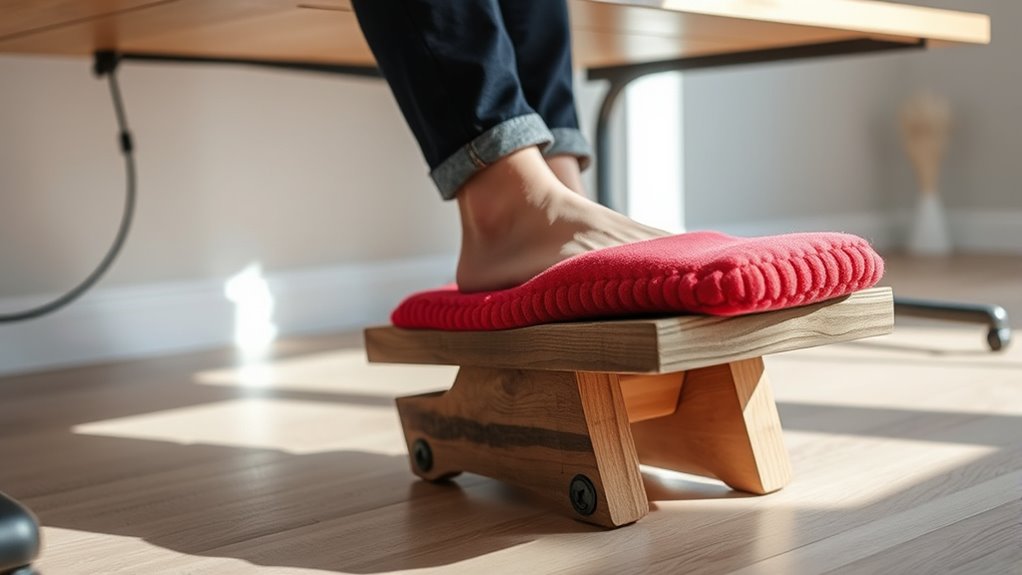
Building an adjustable DIY footrest with recycled materials is a practical way to customize your comfort while reducing waste. Focus on creating an ergonomic design that supports proper circulation and reduces tension in your legs. Use sturdy, recycled wood or plastic to guarantee stability, and secure all parts tightly to prevent accidents. When assembling, consider safety considerations like rounded edges and non-slip pads to prevent slipping or injury. Adjustable features, such as removable or movable sections, allow you to change the height and angle as needed. Keep the structure simple yet robust, ensuring it can handle daily use without wobbling. Ensuring proper stability and safety is essential for effective and lasting comfort. By prioritizing safety and ergonomic principles, your recycled materials footrest will promote better circulation and lasting comfort.
Creating a Portable Footrest With a Foldable Design
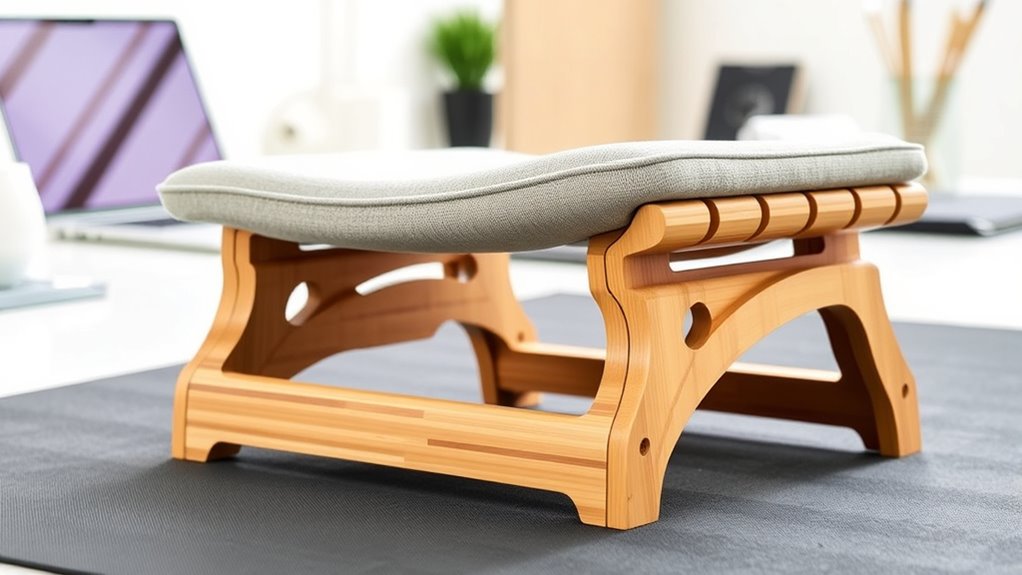
A foldable footrest offers a convenient solution for those who need comfort on the go or limited space at home or work. Its ergonomic design supports proper circulation and reduces fatigue. When creating yours, focus on portability considerations, ensuring it’s lightweight yet sturdy. Use durable materials like foldable wood or reinforced fabric with hinges for easy folding. Consider adding a handle or strap for effortless carrying. The design should allow quick setup and compact storage, fitting into briefcases or backpacks. To enhance comfort, include a textured surface or padding. Below is a simple comparison:
| Feature | Benefit | Material Ideas |
|---|---|---|
| Foldability | Easy storage and transport | Plywood, fabric hinges |
| Lightweight | Portable on the go | Aluminum, canvas |
| Ergonomic shape | Promotes circulation | Molded foam, padded surface |
| Handles or straps | Convenient to carry | Nylon, leather strap |
This way, your DIY portable footrest blends ergonomic design with portability considerations seamlessly.
Incorporating Household Items for a Budget-Friendly Solution

If you’re looking to create an affordable footrest, using common household items can be an effective and budget-friendly approach. Items like a sturdy stack of books, a folded towel, or an empty shoebox can serve as a supportive base. These options provide ergonomic benefits by elevating your feet to encourage proper posture and reduce strain. Additionally, they promote circulation improvement by preventing blood from pooling in your legs. Adjust the height to suit your comfort, ensuring your feet are supported without causing pressure. Covering these items with a soft cloth or cushion adds extra comfort. This simple, cost-effective method allows you to customize your footrest easily, making it a practical DIY solution that enhances your seated experience without breaking the bank. Active listening and empathy are also important to consider when making adjustments to ensure your comfort and well-being.
Frequently Asked Questions
What Are the Best Materials for Maintaining Footrest Durability?
When considering material selection for a footrest, durability factors are key. You should look for sturdy materials like hardwood, metal, or high-quality plastic that can withstand daily use. These materials offer strength, resistance to wear, and longevity. Avoid cheap or flimsy options, as they won’t hold up over time. Prioritize durability factors to guarantee your footrest remains stable and effective, supporting your circulation comfortably for years to come.
How Can I Customize the Height of My DIY Footrest?
To customize the height of your DIY footrest, start by choosing adjustable components like stackable blocks or adjustable legs. You can also add or remove layers of foam or padding for precise height adjustment. Using custom height options allows you to tailor your footrest to your comfort. Simply experiment with different stack heights or adjustable parts until you find the perfect fit, ensuring peak circulation and comfort while seated.
Are There Safety Tips for Using Recycled Materials as Footrests?
When using recycled materials as footrests, prioritize recycling safety by thoroughly inspecting each item for sharp edges, splinters, or unstable parts that could cause injury. Always clean and sanitize the materials before use. Avoid weak or damaged objects that might break under pressure. By carefully inspecting your recycled materials, you guarantee a safe, eco-friendly footrest that supports your circulation comfortably.
How Do I Ensure My DIY Footrest Is Stable During Use?
To guarantee your DIY footrest stays stable during use, focus on footrest slip prevention by choosing a non-slip surface or adding rubber pads underneath. Use proper weight distribution techniques by evenly placing your feet and avoiding excessive pressure on one side. Secure the footrest to the floor if possible, and test its stability before extended use. These steps help keep your footrest safe and effective for improving circulation.
Can These Solutions Accommodate Different Seating Arrangements?
Imagine tailoring your comfort to fit any setting. When considering your footrest, adjustable designs and portable options are your best friends, easily adapting to various seating arrangements. These solutions offer flexibility, ensuring you can create a cozy, supportive spot no matter where you sit. With a bit of ingenuity, your DIY footrest can seamlessly transform to meet your needs, providing consistent comfort and improved circulation wherever you go.
Conclusion
So, there you have it—your foolproof guide to turning household chaos into a circulation-boosting masterpiece. Who knew that a stack of magazines or a recycled crate could save your legs from the perils of poor circulation? Forget expensive gadgets; with a little creativity, you’re now the proud owner of a stylish, budget-friendly footrest. Go ahead, give your feet the VIP treatment—they’ve earned it, and your wallet will thank you too.
